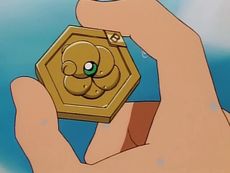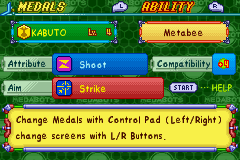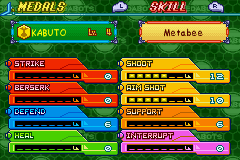Medal

A Medal (メダル) is a small, hexagonal, coin-like object containing an artificial intelligence. It serves as the "brain" of a Medarot, becoming active when inserted into a Tinpet or Medarotch.
There are various types of Medals, each typically represented by a stylized image on its front face. This image can evolve as the Medal matures; for instance, the picture on a Kabuto Medal initially resembles a larva but transforms into a fully developed beetle as the Medal gains experience.
Different Medal types are more compatible with specific kinds of parts. For example, the Kabuto Medal excels in shooting and ranged attacks, while others like the Mermaid Medal are better suited for support roles. This distinction is known as the Medal's Attribute. To optimize performance, a Medarotter should be aware of their Medarot's Medal type and select parts that complement its unique strengths.
In addition to their names and images, different Medal types are identified by a letter or symbol printed at the top of their front face. The Kuwagata Medal is denoted by the letter "A," the Kabuto Medal by "B," and the Mermaid Medal by "N," among others. The specific letter associated with each Medal depends on the context, as various sets of Medals have been manufactured over time, typically ranging from A to Z and including a few special medals. However, more recent games starting with Medarot DS have moved away from this letter-based system.
Medals originally came in various colors, especially when the games are played on the Super Game Boy or Game Boy Color. However, due to the influence of the anime, gold eventually became the default color for all medals. Beginning with Medarot DS, a medal starts as pale green, turns silver at its second stage, and finally becomes gold in its final stage.
History
The original Medals were not created by humans; they were discovered as fossils deep within the earth, believed to be of extraterrestrial origin, left behind by an ancient race of sentient robots.
When it was discovered that these Medals contained a form of artificial intelligence, efforts were made to develop robots capable of utilizing them, leading to the creation of Medarots. As the supply of original Medals dwindled, mass production began for man-made Medals to meet demand. In the current era, most Medals in use are these man-made replicas, though some intact original Medals, known as "Rare Medals" (レアメダル), still exist.
While all Medarots have their own personalities, those with rare Medals are more likely to achieve an advanced self-awareness, giving them more independent and distinct personalities.
Medaforce
- Main article: Medaforce
The Medaforce (メダフォース) ability, introduced in Medarot 2, is directly linked to the Medal used by a Medarot. All Medals can use the Medaforce, with a maximum of three different ones, but Medarotters were only able to utilize this ability with the new Medarotch model.
In the anime and manga series, the use of Medaforce abilities is primarily limited to Rare Medals. This is because Rare Medals contain hidden information that man-made Medals do not replicate. However, in the anime series, some man-made Medals can unlock their Medaforce abilities when placed in intense situations. In Medarot Re-Reloaded, any Medal can learn Medaforce abilities, with varying rarities such as Normal, Epic, Rare, and Legend.
In the games
Each game in the Medarot series features a variety of Medals that players can collect. These Medals are typically not available for purchase; instead, they are found or given to the player at specific points in the story. Starting from Medarot 3, most of the RPG games in the series allow players to name their Medals, though Medarot DS does not include this feature.
Medal Stats and Properties


The handling of Medal stats has evolved significantly throughout the series. However, most of the RPG games maintain the following core parameters for Medals:
- Attribute: This indicates the category of parts with which the Medal is compatible. In Medarot 1, 2, R, and 2 Core, each Medal is assigned a distinct attribute. In Medarot 3, 4, 5, and Navi, a different system is used, with broader categories and some overlap between Medals. Medarot DS does not include Medal attributes.
- Compatibility Bonus: A numerical value added to the success rate of all the Medal's actions for every compatible part it has equipped. This means that some Medals gain a greater benefit from using compatible parts than others (Medarot DS also does not feature this bonus).
- Nature or Target: Determines which Medarots or parts the Medal is more likely to target. In Medarot 7, some natures come with additional passive effects, such as increased damage or reduced charge time.
- Level: Medals typically gain levels by accumulating experience points from battles. A Medal's level influences its base accuracy and damage, as well as determining when its image changes and when it learns Medaforce abilities. However, some games, like Medarot DS, do not use experience points. Instead, they calculate the Medal's overall level based on the combined levels of all its skills.
- Skill Levels: Each Medal has a set of 3-10 skill levels that reflect how proficient it is at performing certain actions. Every in-battle action is associated with a specific skill, and a Medal's level in that skill directly affects the action's success rate. Skill levels increase by repeatedly using actions linked to that skill. In some games, such as Medarot 3, 4, Navi, DS, and 7, Medals can naturally gain levels only in specified skills.
- Evolution: A Medal's evolution is closely tied to its level. In Medarot 1, 2, R, 3, 4, and Navi, Medals evolve through five ranks: Rank 1 at level 0, Rank 2 at level 10, Rank 3 at level 30, Rank 4 at level 60, and Rank 5 at level 100. In Medarot 5, Medals can evolve into different forms with varying properties. Evolution occurs at level 20, with two possible Rank 2 forms, at level 40 with three different Rank 3 forms, and finally at level 60, where Medals can evolve into one of up to four different Rank 4 forms.
Other features are less universal and only appear in certain games:
- Medaforce or Medaskill: Introduced in Medarot 2, each Medal can have one to three Medaforce abilities unlocked at specific levels. These abilities require Medaforce points, which can be charged up during battle. In Medarot 5, Medaforce is referred to as "Medaskill".
- Leader Skills: Exclusive to Medarot 5, these are powerful abilities that affect the entire team when the Medal is selected as the leader. Leader Skills are unlocked after the Medal is used as the leader in 100 battles.
- Medalias: Found in Medarot 3, 4, DS, and 7, Medalias are small jewels that can be placed in the Medal's slots to enhance its abilities, either by boosting skills or adding special effects.
- Rotation: Added in Medarot 3 and present in all subsequent games except Medarot DS, Rotation allows players to pre-program a set of commands for Auto-battle mode. Commands can include arm or head actions, Medaforce, Medachange, and movement (in Medarot Navi). Without a set Rotation, the Medarot will use random commands during Auto-battle.
- Additional Stats: Medarot 1 includes three extra Medal stats (Attack, Defense, and Special) that determine the Medal's nature. These stats can be modified by changing the types of parts equipped on the Medarot. (See Medal stats for further details).